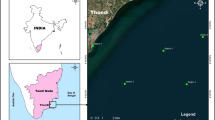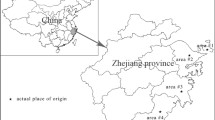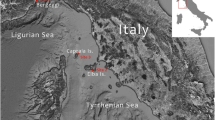Abstract
Seaweed consumption has increased considerably in Europe as a result of new trends in food. The macroelement (Na, Ca, K, Mg) and trace element (B, Ba, Co, Cr, Cu, Fe, Li, Mn, Mo, Ni, Sr, V, Zn) levels in different species of edible brown seaweeds were determined by inductively coupled plasma optical emission spectrometry (ICP-OES). European Himanthalia elongata species had the highest recorded concentrations of K (57480 mg/kg dry weight). Asian Undaria pinnatifida species had the highest Fe content (58.8 mg/kg dw). Five grams/day of dehydrated seaweed of the Asian U. pinnatifida species mainly contributes to the admissible daily intake of Mg (9.32% adults) and Na (7.05% adults). In any case which exceeds the maximum intake values of any of the elements analyzed, the macro- and trace element levels can vary considerably in a short period of time, so it is necessary to assess the toxic risk in edible seaweeds.
Similar content being viewed by others
References
AECOSAN (Agencia Española de Consumo, Seguridad Alimentaria y Nutrición) (2006) Spanish model diet for the determination of consumer exposure to chemicals. Ministry of Health, Social Services and Equality. Madrid, Spain, https://doi.org/10.1037/1091-7527.24.2.137
Bocanegra A, Bastida S, Benedí J, Ródenas S, Sánchez-Muniz FJ (2009) Characteristics and nutritional and cardiovascular –health properties of seaweeds. J Med Food 12:236–258. https://doi.org/10.1089/jmf.2008.0151
Brito GB, de Souza TL, Bressy FC, Moura CWN, Korn MG (2012) Levels and spatial distribution of trace elements in macroalgae species from the Todos los Santos Bay, Bahía Brazil. Mar Pollut Bull 64:2238–2244. https://doi.org/10.1016/j.marpolbul.2012.06.022
Chakraborty S, Bhattacharya T, Singh G, Maity JP (2014) Benthic macroalgae as biological indicators of heavy metal pollution in the marine environments: a biomonitoring approach for pollution assessment. Ecotox Environ Safe 100:61–68. https://doi.org/10.1016/j.ecoenv.2013.12.003
Das KK, Das SN, Dhundasi SA (2008) Nickel, its adverse health effects & oxidative stress. Indian J Med Res 128:412–425
Domínguez-Ortega L, Medina Ortiz O, Cabrera García-Armenter S (2006) Intoxicación con litio. Anal Med Int 23(9):441–445
EFSA (European Food Safety Authority) (2004) Opinion of the scientific panel on dietetic products, nutrition and allergies on a request from the commission related to the tolerable upper intake level of boron (Sodium Borate and Boric Acid). EFSA J 80:1–22
EFSA (2014) Scientific opinion on dietary reference values for chromium. EFSA J 12(10):3845. https://doi.org/10.2903/j.efsa.2014.3845
EFSA (2005) Opinion of the scientific panel on dietetic products, nutrition and allergies on a request from the commission related to the tolerable upper intake level of nickel. EFSA J 146:1–21
EFSA (2009) Scientific Opinion on the substantiation of health claims related to magnesium and electrolyte balance (ID 238), energy-yielding metabolism (ID 240, 247, 248), neurotransmission and muscle contraction including heart muscle (ID 241, 242), cell division (ID 365), maintenance of bone (ID 239), maintenance of teeth (ID 239), blood coagulation (ID 357) and protein synthesis (ID 364) pursuant to Article 13(1) of Regulation (EC) No 1924/20061. EFSA J 7(9):1216
EFSA (2015) Scientific opinion on the risks to public health related to the presence of nickel in food and drinking water. EFSA J 13(2):4002–4204
EFSA (2016) Dietary reference values for potassium. EFSA J 14(10):4592
Farias DR, Hurd CL, Eriksen RS, Macleod CK (2018) Macrophytes as bioindicators of heavy metal pollution in estuarine and coastal environments. Mar Pollut Bull 128:175–184. https://doi.org/10.1016/j.marpolbul.2018.01.023
FAO (Food and Agriculture Organization of the United Nations) (2018) The global status of seaweed production, trade and utilization. Globefish Research Programme 124:120
Fung A, Hamid N, Lu J (2013) Fucoxanthin content and antioxidant properties of Undaria pinnatifida. Food Chem 136:1055–1062. https://doi.org/10.1016/j.foodchem.2012.09.024
Gómez-Ordóñez E, Jiménez-Escrig A, Rupérez P (2010) Dietary fibre and physicochemical properties of several edible seaweeds from the northwestern Spain coast. Food Res Int 43:2289–2294. https://doi.org/10.1016/j.foodres.2010.08.005
González-Weller D, Rubio C, Gutiérrez AJ, González GL, Caballero-Mesa JM, Revert C, Hardisson A (2013) Dietary intake of barium, bismuth, chromium, lithium, and strontium in a Spanish population (Canary Islands, Spain). Food Chem Toxicol 62:856–868. https://doi.org/10.1016/j.fct.2013.10.026
Graudal N, Jürgens G, Baslund B, Alderman MH (2014) Compared with usual sodium intake, low- and excessive-sodium diets are associated with increased mortality: a meta-analysis. Americ J Hypert 27(9):1129–1137. https://doi.org/10.1093/ajh/hpu028
Gutiérrez AJ, González-Weller D, González T, Burgos A, Lozano G, Hardisson A (2008) Content of trace metals (iron, zinc, manganese, chromium, copper, nickel) in canned variegated scallops (Chlamys varia). Int J Food Sci Nutr 59:535–543
IOM (Institute of Medicine) (2001) Food and Nutrition Board of the Institute of Medicine of the National Academies. Dietary reference intakes for vitamin a, vitamin k, arsenic, boron, chromium, copper, iodine, iron, manganese, molybdenum, nickel, silicon, vanadium, and zinc. National Academy Press, Washington, USA
IUPAC (International Union of Pure and Applied Chemistry) (1995) International Union of Pure and Applied Chemistry. Nomenclature in evaluation of analytical methods including detection and quantification capabilities. Pure Appl Chem 67: 1699-1723, https://doi.org/10.1351/pac199567101699
Jadeja RN, Batty L (2013) Metal content of seaweeds in the vicinity of acid mine drainage in Almlwch, North Wales U.K. Indian J Mar Sci 42(1):16–20
Jiménez-Escrig A, Gómez-Ordóñez E, Rupérez P (2011) Brown and red seaweeds as potential sources of antioxidant nutraceuticals. J Appl Physiol 77-86. https://doi.org/10.1016/B978-0-12-387669-0.00026-0
Karthick P, Siva Sankar R, Kaviarasan T, Mohanraju R (2012) Ecological implications of trace elements in seaweeds: bio-indication potential for metal contamination in Wandoor, South Andaman Island. Egypt J Aquat Res 38:227–231. https://doi.org/10.1016/j.ejar.2013.01.006
Khaled A, Hessein A, Abdel-Halim AM, Morsy FM (2014) Distribution of heavy metals in seaweeds collected along Marsa-Matrouh beaches, Egyptian Mediterranean Sea. Egypt J Aquat Res 40:363–371. https://doi.org/10.1016/j.ejar.2014.11.007
Krejpcio Z (2001) Essentiality of chromium for human nutrition and health. Pol J Environ Stud 10(6):399–404
Li SX, Lin LX, Zheng FY, Wang QX (2011) Metal bioavailability and risk assessment from edible brown algae Laminaria japonica, using biomimetic digestion and absorption system and determination by ICP-MS. J Agric Food Chem 59:822–828. https://doi.org/10.1021/jf103480y
López-Hidalgo AM (2017) Las macroalgas, ¿pueden ayudarnos a resolver problemas de índole mundial? Uni Potosinos 14(215):4–10
Monitor O (2014) The European Market for Sea Vegetables. Final Report, Organic Monitor:1–36
Pan G (2002) Confidence intervals for comparing two scale parameters based on Levene’s statistics. J Nonpar Stat 4:459–476
Paz S, Rubio C, Frías I, Gutiérrez AJ, González-Weller D, Revert C, Hardisson A (2018) Metal concentrations in wild-harvested phaeophyta seaweed from the Atlantic Ocean (Canary Islands, Spain). J Food Prot 81(7):1165–1170. https://doi.org/10.4315/0362-028X.JFP-18-038
Pravina P, Sayaji D, Avinash M (2013) Calcium and its role in human body. Int J Res Pharmaceut Biomed Sci 4(2):659–668
Rubio C, Napoleone G, Luis-González G, Gutiérrez AJ, González-Weller D, Hardisson A, Revert C (2017a) Metals in edible seaweed. Chemosphere 173:572–579
Rubio C, Paz S, Ojeda I, Gutiérrez AJ, González-Weller D, Hardisson A, Revert C (2017b) Dietary intake of metals from fresh cage-reared hens’ eggs in Tenerife. Canary Islands J Food Qual. https://doi.org/10.1155/2017/5972153
Rubio C, Martínez C, Paz S, Gutiérrez AJ, González-Weller D, Revert C, Burgos A, Hardisson A (2018a) Trace element and toxic metal intake from the consumption of canned mushrooms marketed in Spain. Environ Monit Assess 190:237
Rubio C, Ojeda I, Gutiérrez AJ, Paz S, González-Weller D, Hardisson A (2018b) Exposure assessment of trace elements in fresh eggs from free-range and home-grown hens analysed by inductively coupled plasma optical emission spectrometry (ICP-OES). J Food Compos Anal 69:45–52
Ruíz-Navarro M, Rubio Armendáriz C, Luis González G, Ojeda Feo I, González-Weller D, Gutiérrez Fernández AJ, Hardisson de la Torre A (2013) Metales en algas comestibles: Evaluación y estudio comparativo. Rev Toxicol 30:182–192
Ruusunen M, Puolanne E (2005) Reducing sodium intake from meat products. Meat Sci 70(3):531–541. https://doi.org/10.1016/j.meatsci.2004.07.016
Sangiuliano D, Rubio C, Gutiérrez AJ, González-Weller D, Revert C, Hardisson A, Zanardi E, Paz S (2017) Metal concentrations in samples of frozen cephalopods (cuttlefish, octopus, squid, and shortfin squid): an evaluation of dietary intake. J Food Prot 80(11):1867–1871. https://doi.org/10.4315/0362-028X.JFP-17-184
SCHER (Scientific Committee on Health and Environmental Risk) (2012) Assessment of the tolerable daily intake of barium. European Commission European Union https://doi.org/10.2772/49651
Subba Rao SL, Mantri VA, Ganesan K (2007) Mineral composition of edible seaweed Porphyra vietnamensis. Food Chem 102:215–218
Suter PM (1999) The effect of potassium, magnesium, calcium, and fiber on risk of stroke. Nutr Rev 57(3):84–88. https://doi.org/10.1111/j.1753-4887.1999.tb06928.x
Taboada MC, Millán R, Moguez MI (2012) Nutritional value of the marine algae wakame (Undaria pinnatífida) and nori (Porphyra purpurea) as food supplements. J Appl Physiol 23:543–597
USDA (United States Department of Agriculture) (2016) National Nutrient Database for Standard Reference Release 28. Basic Report: 11669, Seaweed, wakame, raw, https://doi.org/10.1182/blood-2015-11-684118
Valko M, Leibfritz D, Moncol J, Cronin MTD, Mazur M, Telser J (2007) Free radicals and antioxidants in normal physiological functions and human disease. Int J Biochem Cell Biol 39(1):44–84. https://doi.org/10.1016/j.biocel.2006.07.001
WHO (World Health Organization) (2010) Strontium and strontium compound. Concise International Chemical Assessment Document 77: 1-63
WHO (2011) Manganese in DRINKING WAter. Background document for development of WHO Guidelines for Drinking water Quality. Rev.1, https://doi.org/10.1080/02786826.2010.538452
WHO (2012) Guideline: sodium intake for adults and children. World Health Organization, Geneva
Author information
Authors and Affiliations
Corresponding author
Ethics declarations
Conflict of interest
The authors declare that they have no conflict of interest.
Additional information
Responsible editor: Philippe Garrigues
Publisher’s note
Springer Nature remains neutral with regard to jurisdictional claims in published maps and institutional affiliations.
Rights and permissions
About this article
Cite this article
Paz, S., Rubio, C., Frías, I. et al. Human exposure assessment to macro- and trace elements in the most consumed edible seaweeds in Europe. Environ Sci Pollut Res 26, 36478–36485 (2019). https://doi.org/10.1007/s11356-019-06713-7
Received:
Accepted:
Published:
Issue Date:
DOI: https://doi.org/10.1007/s11356-019-06713-7




